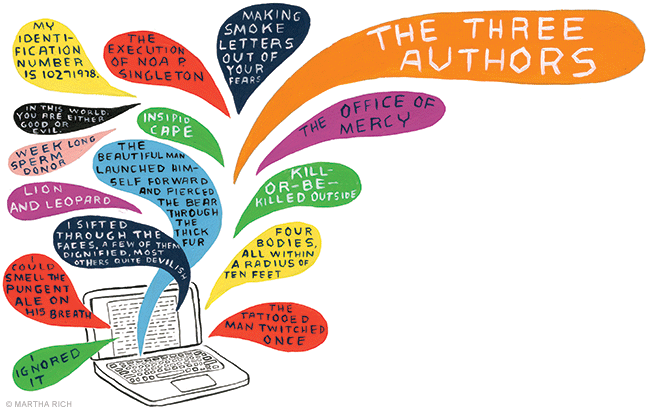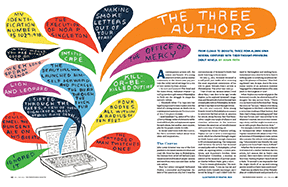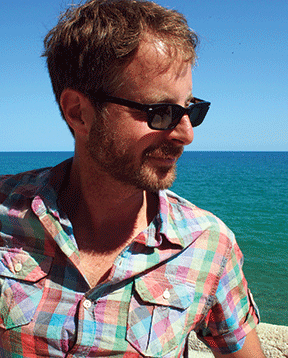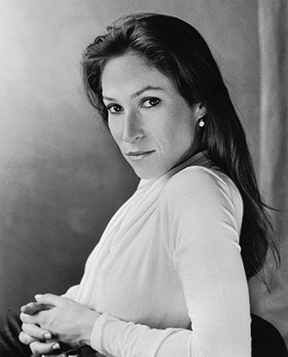
From cloaks to biosuits, three Penn alumni span several centuries with their thought-provoking debut novels.
BY SUSAN FRITH | Illustration by Martha Rich

A contemporary prison cell, the homes and haunts of a young America’s artists, and an insular community in the future year 305 provide the richly varied settings for a trio of first novels by Penn alumni:
• In Lion and Leopard (The Head and the Hand Press), Nathaniel Popkin C’91 GCP’95 travels to 19th-century Philadelphia to flesh out the struggle to shape the nation’s culture.
• Elizabeth Silver C’01 taps into her legal background to take readers into the mind of a young woman on death row in contemporary America in The Execution of Noa P. Singleton (Crown).
• Ariel Djanikian C’04, author of The Office of Mercy (Viking), writes of a futuristic settlement with food, jobs, and replacement organs for each citizen, but another, more sinister, plan for the people outside its walls.
In recent interviews with the Gazette, the three novelists talked about their ideas and inspirations.
The Canvas

John Lewis Krimmel was one of the first painters to document America’s urban and rural life. From his time in Philadelphia, the German-born artist left behind a rare visual record of all kinds of people—women and men from every race and class—in the new nation.
That fact alone intrigued Nathaniel Popkin, a journalist and longtime student of the American city, but it was the circumstances of Krimmel’s death that made him long to know more.
On July 15, 1821, Krimmel drowned in a mill pond, just weeks after receiving the most important commission of his life—to paint William Penn’s arrival in Philadelphia. The artist was only 32.
“That struck me, because [when I read about this], I was close to his age,” recalls Popkin. As he explored Krimmel’s tragic story and the network of artists he must have crossed paths with in Philadelphia, he decided that it was best re-told through fiction.
In Lion and Leopard, three young friends travel to Philadelphia on a quest to interview the best artists in America for a book. Along the way, they find themselves caught in a tangle of alliances and rivalries, witnesses to the tensions between the American art establishment and a new way of making art.
Despite his choice of historic setting, Popkin set out to write a contemporary novel, which he achieves through tongue-in-cheek humor and enough characters to fill a Krimmel painting. The viewpoints shift between the artists that Krimmel crossed paths with in Philadelphia, a fruit seller, an aspiring writer, a Creole prostitute, and Napoleon’s brother. Even Christopher Columbus, a monkey on exhibit at the museum of portrait painter Charles Willson Peale, gets a voice.
“I try to remain philosophic,” the monkey calmly states. “I don my top hat and perform tricks (usually mornings), and I would be lying if I said I didn’t look forward to the laughter and smiling faces. Sometimes I even start to believe there’s nothing quite so satisfying as administering to the pleasure of humans.” That feeling doesn’t last, he says, due to the occasional taunts of an audience member “engorged by a demented sense of his own place in the Kingdom of God.”
When Popkin encountered gaps in the historical records, he allowed himself to imagine his way across them. “There was an historical clothesline that I hung the story on,” he says. “Almost everything that happens in this book is derived from a very close reading of that history. But then I had to keep reminding myself that this was fiction and I was entitled to do whatever I wanted, because I was inventing a story, and that might resonate even more with people than history does.”
For example, to track down the millpond in Germantown where Krimmel died, Popkin consulted with Adam Levine C’80, an historian of Philadelphia’s water system who operates the website www.phillyh2o.org. “I discovered it was literally the next property over from Peale’s farm, Belfield.”
Whether the location was coincidence or evidence of a conflict between the two artists, he’s unsure. But in Peale’s own journal, there were dates cut out around this time, feeding Popkin’s hunch about a clash. “It seemed to me impossible that the tragic death of an up-and-coming painter would not have been mentioned.”
Peale was an elderly lion of the Philadelphia art establishment and patriarch of a family of artists (all named, ambitiously, after European masters like Raphael and Rembrandt). He championed American ideas of reason and order in his own works and in his specimen-stuffed museum. Krimmel, on the other hand, represented a new movement of Romantic artists that were more guided by emotion.
If that were not threat enough, Krimmel appeared to mock Peale in his art. In “Election Day,” Krimmel showed “American democracy in chaos,” Popkin says. The painting was set at the Statehouse, where Peale’s museum was located: “There’s fist-fighting, old and invalid people being carried in just for their vote, stealing, all this stuff happening.” For a watercolor version of the same work, Krimmel added another touch—a monkey escaping out a museum window.
“To me that was an extraordinary critique. There’s no way he’d put that in accidentally or just for fun,” Popkin says. “That, for me, heightened the sense of conflict there.”
Popkin grew up in Bucks County, near Philadelphia, and both sides of his family are from nearby Trenton. Given those connections, he says, “I’ve always had this narrative in my life about the rise and decline of cities.”
He studied philosophy at Penn, with a minor in urban studies, and then earned his master’s in city planning. “I went from city planning, which was much more prescriptive about what cities could be like, to writing literary nonfiction about what things were like, to just honestly telling stories.”
Popkin did this in two nonfiction books, Song of the City: An Intimate History of the Urban City Landscape and The Possible City: Exercises in Dreaming Philadelphia before walking the cobblestone streets back in time for his novel.
It’s a walk that comes naturally for Popkin, who also serves as senior script editor and writer for the Emmy award-winning documentary series, Philadelphia: The Great Experiment. That project also aims to include many different voices from history, he says.
Hidden City Philadelphia , the web magazine that Popkin founded and co-edits, reports on the city’s evolving built environment as well as its “living” history. “There are events, there are voices, there are people’s lives basically inscripted in the landscape,” he says. “So my exploration of the present necessarily encounters and deals with the past.”
The Needle

While Popkin puzzled over the mindsets of real artists from American history, Elizabeth Silver was busy imagining the motivations of her wittily acerbic protagonist in The Execution of Noa P. Singleton.
Noa sits on death row for the murder of her father’s girlfriend (a Penn alumna). Six months before her scheduled execution, she receives a visit from an idealistic young attorney named Oliver Stansted, whose voice she describes as “docile as a prostrated ocean, as if he had slipped from his mother’s womb begging for a nonprofit position and studio apartment to match. I hated him instantly.”
Stansted informs her that the victim’s mother, Marlene Dixon, is now seeking clemency for her through a newly formed organization, Mothers Against Death. Noa greets the idea with sarcasm:
“You’re kidding? MAD? Mad, like, you mean, like angry?”
Oliver Stansted swallowed and looked back down to his lonely feet before pulling out a stack of papers. “Well, yes, M-A-D.”
“Isn’t that a drunk driving group? Has she been sued yet for copyright infringement?” I laughed. “Oh, wouldn’t that be poetic.”
Marlene finally appears, telling Noa that before she speaks to Pennsylvania’s governor on her behalf, she needs something to show “you have changed. That you are a good person now. That you never meant to do what you did.”
Getting nowhere in that conversation, Marlene finally adds, “I just want to know you. I want to understand.”
According to Silver, what follows is not a “whodunit, but an exploration of guilt through the eyes of two very different, very strong women,” as Noa slowly tells her own story and Marlene addresses her dead daughter.
Among other facts, the reader learns that Noa, too, was briefly a student at Penn, and that she withdrew in her first semester after a medical emergency that unfolded in Van Pelt Library.
Unlike Noa, Silver finished her own course of studies at Penn, majoring in English with a creative-writing concentration. Then she went on to earn her MA in creative writing from the University of East Anglia in England. After working in publishing and teaching for a while, she went to Temple University’s law school. She continued to write, though.
Silver got the idea for her novel in her last few months at Temple. The characters of Noa and Marlene came to her during a capital-punishment course she took that semester, she explains. The course had a clinical component, and her assignment was to work on a clemency petition. In the process of doing so, she got to meet with inmates and interview family members of crime victims. “I started learning about it and becoming fascinated with a lot of issues attached to [these cases], such as guilt and the notion of victimhood.”
Then, in her first job out of law school, Silver held at a two-year clerkship with one of the judges on the Texas Court of Criminal Appeals. Her first assignment was to help draft a death-penalty opinion. (Though she was terrified at the time, the says the procedure was more cut-and-dried than it sounds.) Combing through trial transcripts during that job gave her more material for her book.
Silver says it was important for her novel to include both Noa’s and Marlene’s perspectives because, “in any crime or event at all, people are impacted by each other. A victim is only a victim because of what somebody has done to her, and a perpetrator is only a perpetrator because of what she does to somebody,” she says. “Their stories can’t exist without each other.”
While she awaits death or mercy, Noa serves as a wry commentator on her own case and capital punishment in America. “Truth be told,” she states, “America is not against the death penalty. And to be honest, I’m not entirely certain I am, either.
“Historically,” she goes on to say, “people have never held their morals high enough above their brows to follow through on their firm, yet pliable, beliefs. Rather, we are a species of voyeurs, eager to witness the demise and destruction of one of our own.”
In an equally blunt manner, Noa lists the myriad reasons that people gave to get out of jury duty for her murder trial, remarking, “Their excuses rained like biblical plagues—entertaining, but time-consuming narratives nevertheless”:
“My father’s a lawyer. I can’t be impartial.”
The constant, omnipresent, ever popular excuse.
“My mother’s a policewoman. I can’t possibly be impartial either.”
Slightly less popular, but frequently used.
“My daughter went to Penn.”
Eh …
“My sister works as an art historian.”
Even more eh …
“I’m a teacher, and my students are having their AP examinations.”
Perhaps, if they’ll all flunk because you can’t stick a sheet of paper into a Scantron grader.
Her list goes on.
“I don’t believe in the death penalty.”
I do.
“I had a hysterectomy last year.”
And I care because …
“I hate authority.”
I have no idea what to do with you, and neither do the lawyers.
“Kill’er, I don’t care! I believe in the death penalty.”
Hello prosecution!
“I’m a police officer. I see these cases all the time.”
Hello prosecution again.
“I mean, I could follow the law if I was told to, but I don’t know that I could follow the law if I was told to. You know what I mean?”
I don’t. I really don’t.
“I loved writing that chapter,” says Silver, who now lives in Los Angeles and works full-time as a writer. “It’s probably something every lawyer on the planet and every person who’s been on jury duty has thought of at some point.”
In contrast to the outspoken Noa, Silver chooses not to air her own views about the death penalty, lest it change people’s reading of the novel. “I just wanted to open a debate about it without stepping on a soapbox,” she says. “I hope that people read the book and form their own opinions.”
The Biosuit

Ariel Djanikian’s futuristic novel examines another kind of state-sponsored killing. The Office of Mercy takes place centuries after a devastating Storm has wiped out most of the world’s population. America-Five is one of 158 domed settlements stretched across the continent at latitude 39 degrees North. While those who live within have access to a wealth of resources, the so-called tribespeople who live beyond it are the targets of “merciful” extermination.
As the book opens Natasha Wiley, a young worker in America-Five’s Office of Mercy, is unsettled after a sweep, or mass killing, of tribespeople dwelling outside the Dome.
Even though she’s been taught from an early age to guard against “misplaced empathy” and to regard life on the Outside as undesirable, something causes her to question the moral code she’s grown up with and to seek answers outside her community.
Just how far removed from nature this society has become is apparent during a mission that takes several America-Five citizens Outside for the first time:
Natasha took a deep breath. The air tasted different, its plasticky coolness now seeming to mask a musky, thicker air beneath, and a scent like what one might experience in a fallow pasture room in the Farms.
Eric went to the nearest shelf and ran one gloved hand over the surface. He held up the circle of dirt on his finger for show.
“This is gross,” he said.
Speaking from her home in Chapel Hill, North Carolina, Djanikian explains that she drew partly from her experiences as a chemistry major at Penn to describe the cold physical setting of America-Five. “I just loved the kind of clean, sterile, organized environment [of] the labs I worked in,” she says. “Where everything has a proper place. And the windows don’t open, so the chemical vapors don’t escape into Philadelphia.”
But the dystopic settlement takes those conditions too far. “It’s a group of people and a place that have totally closed themselves off” from the outside world, Djanikian says.
“In their minds it’s underground,” she explains. (The book describes its structure as a “concrete and lead-enforced flower, buried to its head.”) “But it has actually risen above the rules of nature and the rules of being a human. They’ve extended their lives and rejected their inheritance as human animals.”
At least the spirit of competition is thriving in America-Five. In one scene Natasha and a coworker check the America Boards to see how their own settlement ranks in the continent’s tally of “sweeps.”
“Did you know we’re ahead of America-Forty-seven now?” one of Natasha’s coworkers asks her. “Way ahead of America-Six.”
The two of them scroll down the screen for details, awed to learn that, “The total count, the number of human beings on the North American continent granted mercy since the Storm was 8,300,019.”
“We’re the ones to push it over 8.3 million. Mother,” [Eric] said in a hushed voice, “all those people.”
Though Djanikian didn’t set out to write a book with a message, she does see in it a cautionary tale about inequality. Should a society put all its resources into pursuing technological and scientific developments that are only available to a select few? she asks. Or should it work to ensure that all people’s situations are bettered? While it may be easier to “go back and judge people of other generations,” she says, “it is interesting to me to think forward a bit and wonder how will we be judged?”
Taking time alone to think through such ideas is something that she saw her own parents do growing up. Her father, the poet Gregory Djanikian C’71, who directs Penn’s Creative Writing Program, and her mother, Alysa Bennett GFA’85, an artist, were “definitely, in more ways than I know, influential” through their own creative habits, she says.
Though her father didn’t read The Office of Mercy before it was published, “he’s definitely been an influence on all aspects of my writing,” Djanikian adds. “My dad has an ear for a good line. His enthusiasm for books and the written word I’m sure shaped and strengthened my own sensibilities. He’s also someone who values precision of language and precision of thought—good things for a novelist to keep in mind.”
When she started at Penn, Djanikian planned to pursue a career in the sciences. Writing, once a side interest, gradually took over.
In addition to the example of her parents’ artistic pursuits, Djanikian also honed her writing skills in creative writing workshops led by the fiction-writer and memoirist Max Apple, who teaches in Penn’s English Department. “He’s a stand-out teacher,” she says, “and someone who has strong, rigorous ideas about style—something that is extremely valuable when you’re forming your own voice.” (Djanikian also met her husband, Phil Sandick C’03 CGS’06, in Apple’s workshop, where they passed the first dating test of reading each other’s stories.) After Penn, she earned her MFA at the University of Michigan.
Now working on two additional book projects, including a prequel to The Office of Mercy, Djanikian isn’t sorry she left the sciences to write:
“The simple answer is that I realized I prefer tinkering with sentences over tinkering with molecules,” she explains. “But more broadly, novels are a place where you can deal with the big ideas of science in the context of the lives of your characters.”
Djanikian adds, “Even before I switched to chemistry, I had started out as a physics major. At a certain point, though, I realized I wasn’t only interested in questions like, “What’s the nature of the universe?” I was also interested in who was doing the asking, and why.”
Freelance writer Susan Frith is a former associate editor for the Gazette. She is working on a novel set in 19th-century Philadelphia.

